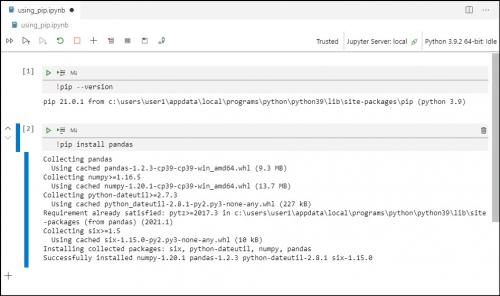Настройка VS Code для работы с Python. Python + Visual Studio Code = успешная разработка
- Настройка VS Code для работы с Python. Python + Visual Studio Code = успешная разработка
- Python в Visual Studio Code. Editing Python in Visual Studio Code
- Как установить Python в Visual Studio Code. Visual Studio Code
- Расширение Python для Visual Studio Code. Python (3 Part Series)
- VS Code не видит библиотеку Python. Fix Python Unresolved Import in VSCode
- Как писать на Python в Visual Studio Code. Getting Started with Python in VS Code
- Установка библиотек Python Visual Studio Code. Installing a Python Library in Visual Studio Code - Windows
Настройка VS Code для работы с Python. Python + Visual Studio Code = успешная разработка
Суперсет Python и Visual Studio Code в действии! Полное руководство по настройке и началу работы на лучшем языке в лучшем редакторе.
от– легкий и удобный редактор кода, доступный на всех платформах и невероятно гибкий. Это отличный выбор для программирования на Python.
В этой статье мы рассмотрим способы установки и настройки максимально эффективной рабочей среды для разработки.
Статья предназначена для программистов, уже имеющих опыт работы с Python и установивших на свою рабочую машину интерпретатор этого языка программирования (Python 2.7, Python 3.6/3.7, Anaconda или другой дистрибутив).
Установка Python – дело несложное: вы найдете подробное пошаговое руководство для всех популярных ОС. Помните, что в разных операционных системах интерфейс VS Code может немного различаться.
Установка и настройка Visual Studio Code для разработки на Python
Сразу же отметим, что VS Code не имеет практически ничего общего с его знаменитым тезкой Visual Studio.
Редакторна любую платформу: наесть подробные инструкции для ,и.
Продукт ежемесячно обновляется и улучшается. В него из коробки встроена поддержка нескольких языков и удобная.предельно прост и понятен.
VS Code + Python
С 2018 года есть. Наблюдать за развитием отношений этой пары можно в.
Основные возможности редактора:
- Поддержка Python 3.4 и выше, а также Python 2.7
- Автоматическое дополнение кода с помощью
- conda и виртуальных сред
- Редактирование кода ви
А вот пара полезных подборок для прокачки Python-скиллов:
- для Atom, Sublime Text, Emacs, Vim, PyCharm и множества других редакторов
- Настраиваемые
- для множества языков, включая русский
В редакторе есть и полезные фичи, не связанные напрямую с языком:
И еще несколько крутых возможностей для полного счастья:
- GitLens – множество полезных функций Git прямо в редакторе, включая аннотации blame и просмотр репозитория.
- между различными устройствами с помощью GitHub.
- Удобная работа с.
Чтобы найти и установить необходимые расширения и темы, нажмите на иконку Расширения на левой панели. Можно искать по ключевым словам и сортировать результаты поиска.
Найдите расширение Python и установите его, чтобы продолжить настройку редактора.
Файлы конфигурации
В Visual Studio Code вы легко можете. Здесь есть параметры пользователя, которые являются глобальными, и параметры рабочей области – локальные для конкретных папок или проектов. Локальные настройки сохраняются в виде .json-файлов в папке .vscode .
Новый проект на Python
Чтобы открыть новый файл, нужно зайти в меню Файл и выбрать пункт Создать или нажать горячую комбинацию клавишCtrl+N.
Еще в редакторе есть полезная палитра команд, которую можно вызвать сочетаниемCtrl+Shift+P. Для создания нового файла введите в появившемся поле File: New File и нажмитеEnter.
Какой бы способ вы ни выбрали, перед вами должно открыться вот такое окно:
Здесь уже можно вводить код вашей программы.
Начинаем кодить
Для демонстрации возможностей редактора напишем "" – известный алгоритм для нахождения простых чисел до некоторого предела. Начнем кодить:
sieve =
На экране это будет выглядеть примерно так:
Подождите, что-то не так. Почему-то VS Code не выделяет ключевые слова языка, не дополняет, не форматирует и вообще ничего полезного не делает. Зачем он вообще такой нужен?
Без паники! Просто сейчас редактор не знает, с каким файлом он имеет дело. Смотрите, у него еще нет названия и расширения – только какое-то неопределенное Untitled-1 . А в правом нижнем углу написано Plain Text (простой текст).
Python в Visual Studio Code. Editing Python in Visual Studio Code
Visual Studio Code is a powerful editing tool for Python source code. The editor includes various features to help you be productive when writing code. For more information about editing in Visual Studio Code, seeand.
Autocomplete and IntelliSense
IntelliSense is a general term for code editing features that relate to code completion. Take a moment to look at the example below. When print is typed, notice how IntelliSense populates auto-completion options. The user is also given a list of options when they begin to type the variable named greeting .
Autocomplete and IntelliSense are provided for all files within the current working folder. They're also available for Python packages that are installed in standard locations.
For more on IntelliSense generally, see.
Tip : Check out the IntelliCode extension for VS Code . IntelliCode provides a set of AI-assisted capabilities for IntelliSense in Python, such as inferring the most relevant auto-completions based on the current code context. For more information, see the IntelliCode for VS Code FAQ .
Customize IntelliSense behavior
Enabling the full set of IntelliSense features by default could end up making your development experience feel slower, so the Python extension enables a minimum set of features that allow you to be productive while still having a performant experience. However, you can customize the behavior of the analysis engine to your liking through multiple settings.
Enable Auto Imports
Pylance offers auto import suggestions for modules in your workspace and/or packages you have installed in your environment. This enables import statements to be automatically added as you type. Auto imports are disabled by default, but you can enable them by settingpython.analysis.autoImportCompletionstotruein your settings.
import matplotlibas a suggestion, but not python.analysis.packageIndexDepthssetting (check out theto learn more). User defined symbols (those not coming from installed packages or libraries) are only automatically imported if they have already been used in files opened in the editor. Otherwise, they will only be available through the.Enable IntelliSense for custom package locations
To enable IntelliSense for packages that are installed in non-standard locations, add those locations to thepython.analysis.extraPathscollection in yoursettings.jsonfile (the default collection is empty). For example, you might have Google App Engine installed in custom locations, specified inapp.yamlif you use Flask. In this case, you'd specify those locations as follows:
Windows:
macOS/Linux:
For the full list of available IntelliSense controls, you can reference the Python extensionand.
You can also customize the general behavior of autocomplete and IntelliSense, even disable the features completely. You can learn more in.
Troubleshooting IntelliSense
For autocomplete and IntelliSense issues, check the following causes:
| Cause | Solution |
|---|---|
| Pylance seems slow or is consuming too much memory when working on a large workspace. | If there are subfolders you know can be excluded from Pylance's analysis, you can add their paths to thepython.analysis.excludesetting to see if performance improves. Alternatively, you can try settingpython.analysis.indexingtofalseto disable Pylance's indexer ( Note : this will also impact the experience of completions and auto imports. Learn more about indexing in). |
| Pylance is only offering top-level symbol options when adding imports. | Try increasing the depth to which Pylance can index your installed libraries through thepython.analysis.packageIndexDepths. Check. |
| The path to the python interpreter is incorrect | |
| The custom module is located in a non-standard location (not installed using pip). | Add the location to thepython.autoComplete.extraPathssetting and restart VS Code. |
Как установить Python в Visual Studio Code. Visual Studio Code
Расширение Python для Visual Studio Code с открытым исходным кодом включает в себя другие общедоступные пакеты Python, чтобы предоставить разработчикам широкие возможности для редактирования, отладки и тестирования кода. Python — самый быстроразвивающийся язык в Visual Studio Code, а соответствующее расширение является одним из самых популярных в разделе Marketplace, посвященном Visual Studio Code!Чтобы начать работу с расширением, необходимо сначалаVisual Studio Code, а затем, следуя нашему руководству, установить расширение и настроить основные функции. Рассмотрим некоторые из них.Прежде всего необходимо убедиться, что Visual Studio Code использует правильный интерпретатор Python. Чтобы сменить интерпретатор, достаточно выбрать нужную версию Python в строке состояния:Селектор поддерживает множество разных интерпретаторов и сред Python: Python 2, 3, virtualenv, Anaconda, Pipenv и pyenv. После выбора интерпретатора расширение начнет использовать его для функции IntelliSense, рефакторинга, анализа, выполнения и отладки кода.Чтобы локально запустить скрипт Python, можно воспользоваться командой «Python: Create Terminal» («Python: создать терминал») для создания терминала с активированной средой. Нажмите CTRL + Shift + P (или CMD + Shift + P на Mac), чтобы открыть командную строку. Чтобы выполнить файл Python, достаточно щелкнуть на нем правой кнопкой мыши и выбрать пункт «Run Python File in Terminal» («Запустить файл Python в терминале»):Эта команда запустит выбранный интерпретатор Python, в данном случае виртуальную среду Python 3.6, для выполнения файла:Расширение Python также включает шаблоны отладки для многих популярных типов приложений. Перейдите на вкладку «Debug» («Отладка») и выберите «Add Configuration…» («Добавить конфигурацию…») в выпадающем меню конфигурации отладки:Вы увидите готовые конфигурации для отладки текущего файла, подключающегося к удаленному серверу отладки или соответствующему приложению Flask, Django, Pyramid, PySpark или Scrapy. Для запуска отладки нужно выбрать конфигурацию и нажать зеленую кнопку Play (или клавишу F5 на клавиатуре, FN + F5 на Mac).Расширение Python поддерживает различные анализаторы кода, для которых можно настроить запуск после сохранения файла Python. PyLint включен по умолчанию, а другой анализатор можно выбрать с помощью команды «Python: Select Linter» («Python: выбрать анализатор кода»):Это еще не все: предусмотрена поддержка рефакторинга, а также модульного тестирования с помощью unittest, pytest и nose. К тому же вы можете использоватьдля удаленной работы над кодом Python вместе с другими разработчиками!
Расширение Python для Visual Studio Code. Python (3 Part Series)
This is part 1 of the series where I share helpful VS code extensions, settings, shortcuts, tips, and tricks to enhance the productivity level of python developers.
Python is a powerful language used in many different applications, and it can be used for web development, data science, computer vision, DevOps, and much more. As such, it is crucial to have the right tools to make coding easier.
In this part of the series, we will explore some of the best VS Code extensions that I've compiled. I use some of them daily, the others I have recently come across. I am going to categorize these extensions into nine sections, as shown in the table of contents below.
Table Of Contents (TOC).
Programming Languages
This section includes extensions used for auto-completion, syntax checking, and more.
This extension allows developers to write and debug code in Python from VS Code. It also provides an interactive console for running Python code and debugging it with breakpoints, call stacks, and an integrated terminal.
For more information, you can refer to:
Pylance
This extension provides rich type information, helping you write better code faster.
For more information, you can refer to:
Jupyter
This extension provides programmers basic notebook support for language kernels that are supported in Jupyter Notebooks.
For more information, you can refer to:
Docker
This extension allows programmers to build, manage, and deploy containerized applications with ease.
For more information, you can refer to:
Code Runner
This extension is similar to, enabling users to quickly and easily run code snippets in their code editor. It can be used for running, testing, and debugging code.
VS Code не видит библиотеку Python. Fix Python Unresolved Import in VSCode
Python is a computer programming language that is easy to learn and use. It is one of the most popular programming languages out there. In this digital age, where everyone is looking for ways to automate their business, Python is on the rise.
One of the many Python error that confuses beginners is Unresolved Import, which happens when the system cannot detect the Python module. In this article, we will show you a few ways to fix Unresolved Import in VSCode and avoid encountering it in the future.
Also check out:
Unresolved Import in VSCode
“Unresolved Import” is an error message produced by VSCode, not Python itself. The message simply means that VSCode cannot detect the correct path for a Python module. The cause of “Unresolved Import” could be one of the following reason:
- VSCode is using the wrong Python path. This is often the case if you’re running your code against a virtual environment. Each environment contains its own binary path that contains different set of package binaries, so a package in one specific virtual environment cannot be found by another and vice versa.
- There might be a missing
.envfile at the root directory of your project that contains additional information about which directory to import modules from. Maybe you were opening VScode in the project’s root directory, however, your module lies in a nested sub directory (usually the.envfile at the root directory. However, this file is often ignored when people push their projects to public Github repository, as it may contain sensitive information.
Set the correct Python path in VSCode
In order to fix Unresolved Import in VSCode , you have to setpython.pythonPathkey in the settings to the correct value. You can quickly open the settings.json. In your workspace settings, you can set your Python path like the following.
Remember to replace/path/to/your/virtualenvironment/bin/pythonwith the correct value. If you’re in a virtual terminal window, you can runwhich pythonto quickly get the path of the current Python interpreter. Once you’re done, reload VSCode, and the error message will go away.
In recent versions of VSCode, there is an alternative way to quickly set thepythonPathvariable using the command interface.
Press Ctrl + Shift + P keyboard combination, then select Python: Select Interpreter , choose the proper one with the packages you need installed, and the problem will be fixed.
Using .env file
You can also create a.envfile in your project root folder to quickly add the proper path to PYTHONPATH environment variable at runtime. Given the example project structure below:
- my_project
- .vscode
- … other folders
- my_code
What you need to do to fix “Unresolved Import” is following these steps
- Create an
.envfile in the workspace folder (here my_project ) - In this newly-created, empty
.envfile, add the linePYTHONPATH=/path/to/module(replace /path/to/module with the actual module you’re trying to import). In this case, we have to replace/path/to/modulewithmy_codeto make Python import module frommy_code - Then, to make sure that VSCode recognizes the
.envfile, place an additional"python.envFile": "${my_project}/.env"line to thesettings.json, similar to how we did in the previous section of this article. - Restart VSCode and verify that the “Unresolved Import” now disappeared.
We hope that the information above is useful to you. If you’re interested in more advanced editing features of VSCode, check out our post on,or.
Как писать на Python в Visual Studio Code. Getting Started with Python in VS Code
This tutorial introduces you to VS Code for Python development - primarily how to edit, run, and debug code through the following tasks:
- Write, run, and debug a Python "Hello World" Application
- Write a simple Python script to plot figures within VS Code
This tutorial is not intended to teach you Python itself. Once you are familiar with the basics of VS Code, you can then follow any of thewithin the context of VS Code for an introduction to the language.
If you have any problems, you can search for answers or ask a question on the.
Prerequisites
To successfully complete this tutorial, you need to first setup your Python development environment. Specifically, this tutorial requires:
- Python 3
- VS Code
Install Visual Studio Code and the Python extension
If you have not already done so, install VS Code .
Next, install the Python extension for VS Code from the Visual Studio Marketplace. For additional details on installing extensions, see Extension Marketplace . The Python extension is named Python and it's published by Microsoft.
Install a Python interpreter
Along with the Python extension, you need to install a Python interpreter. Which interpreter you use is dependent on your specific needs, but some guidance is provided below.
Windows
Install. You can typically use the Download Python button that appears first on the page to download the latest version.
Note : If you don't have admin access, an additional option for installing Python on Windows is to use the Microsoft Store. The Microsoft Store provides installs of supported Python versions .
For additional information about using Python on Windows, see
macOS
The system install of Python on macOS is not supported. Instead, a package management system likeis recommended. To install Python using Homebrew on macOS usebrew install python3at the Terminal prompt.
Note On macOS, make sure the location of your VS Code installation is included in your PATH environment variable. Seefor more information.
Linux
The built-in Python 3 installation on Linux works well, but to install other Python packages you must installpipwith.
Other options
Data Science : If your primary purpose for using Python is Data Science, then you might consider a download from Anaconda . Anaconda provides not just a Python interpreter, but many useful libraries and tools for data science.
Windows Subsystem for Linux : If you are working on Windows and want a Linux environment for working with Python, the Windows Subsystem for Linux (WSL) is an option for you. If you choose this option, you'll also want to install the WSL extension . For more information about using WSL with VS Code, see VS Code Remote Development or try the Working in WSL tutorial , which will walk you through setting up WSL, installing Python, and creating a Hello World application running in WSL.
Verify the Python installation
To verify that you've installed Python successfully on your machine, run one of the following commands (depending on your operating system):
Linux/macOS: open a Terminal Window and type the following command:
python3 --version
If the installation was successful, the output window should show the version of Python that you installed.
Note You can use the
Start VS Code in a workspace folder
.vscode/settings.json, which are separate from user settings that are stored globally.Using a command prompt or terminal, create an empty folder called "hello", navigate into it, and open VS Code (code) in that folder (
mkdir hello cd hello code .
Note : If you're using an Anaconda distribution, be sure to use an Anaconda command prompt.
Alternately, you can run VS Code through the operating system UI, then use File > Open Folder to open the project folder.
Select a Python interpreter
Python is an interpreted language. Thus, in order to run Python code and get Python IntelliSense, you must tell VS Code which interpreter to use.
kb(workbench.action.showCommands)), start typing the Python: Select Interpreter command to search, then select the command. You can also use theoption on the Status Bar if available (it may already show a selected interpreter, too):The command presents a list of available interpreters that VS Code can find automatically, including virtual environments. If you don't see the desired interpreter, see.
Установка библиотек Python Visual Studio Code. Installing a Python Library in Visual Studio Code - Windows
In this quick blogpost, I will share the steps that you can follow in order to install a Python library using pip through either theTerminalor aJupyter Notebookin Visual Studio Code (VSCode) on a Windows computer.
Pre-requisites
In order to complete the steps of this blogpost, you need to install the following in your windows computer:
Visual Studio Code: you can find the steps to install it here . Python Extension for Visual Studio Code: you can find the steps to install it here . Python Interpreter: you can find the steps to install it here .Installing a Python Library Using the Terminal in VSCode
1) Accessing Visual Studio Code Terminal
- Open VSCode application
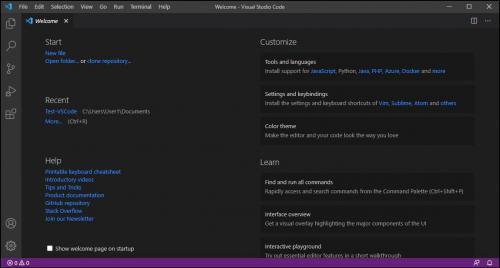
- Go to the
Terminalmenu and selectNew Terminal.
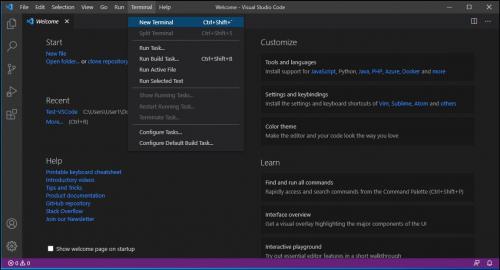
- A new
terminal(PowerShell based) window is opened.
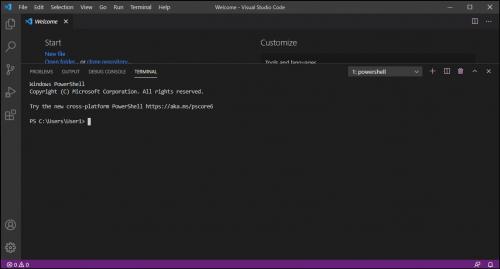
2) Importing a Python Library
- Run the following command to validate that pip is installed in your computer.
pip --version

- Let us say that you want to install
PandasPython library. - Run the following command
pip install pandas
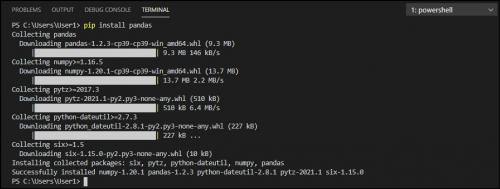
- Create a Jupyter Notebook following the steps of My First Jupyter Notebook on Visual Studio Code (Python kernel)
- Run the following command to validate that pip is installed in your computer.
!pip --version - Let us say that you want to install
PandasPython library. - Run the following command.

Installing a Python Library Using a Jupyter Notebook in VSCode
1) Creating a Jupyter Notebook in VSCode
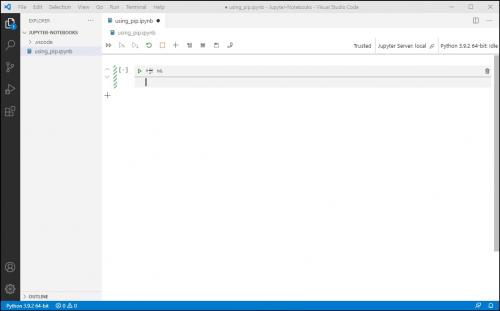
2) Importing a Python Library

